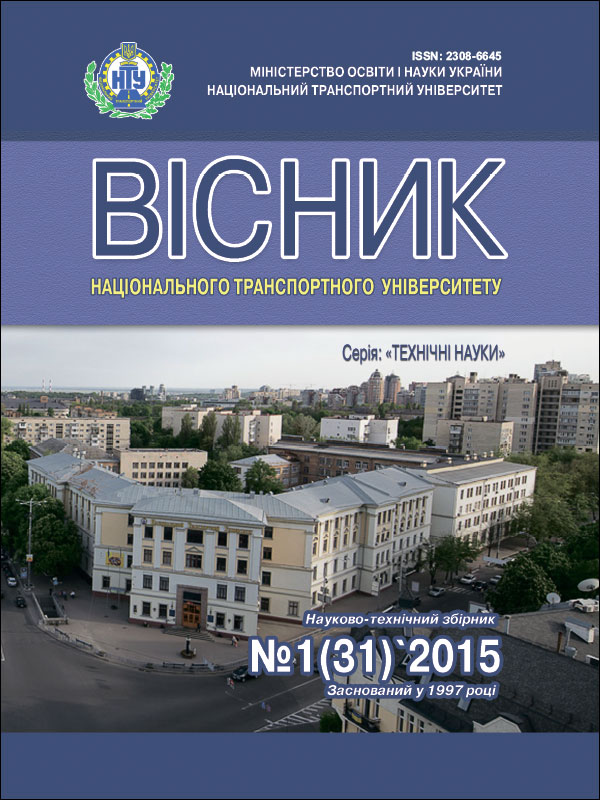MODELING OF ROUTE FUNCTIONING OF THE PASSENGER TRANSPORT SYSTEM TAKING INTO ACCOUNT THE QUALITY CRITERIAS OF PASSENGER SERVICES AND QUARANTINE RESTRICTIONS
ABSTRACT
Sokulskyi O.E., Hilevska K.Y., Vasiltsova N.M. Modeling of route functioning of the passenger transport system taking into account the quality criterias of passenger services and quarantine restrictions Visnyk National Transport University. Series «Technical sciences». Scientific and Technical Collection. - Kyiv: National Transport University, 2021. - Issue 1 (48).
This article examines the analysis of the functioning of the urban passenger transport system in the context of the COVID-19 pandemic. Parameters of indicators of passengers' quality of services on routes flights are defined by means of software of discrete-event simulation modeling. The proposed simulation model of the system «passenger - stop - passenger vehicle» is considered in terms of the theory of queuing systems.
The object of study - aspects of the functioning of the urban passenger transport system in pandemic conditions.
The purpose of the work is to investigate the requirements for the organization and functioning of the urban passenger transport system in pandemic conditions to increase the efficiency of the transport complex of the country.
The research method - research and analysis of the urban passenger transport system functioning in different conditions.
The operation of the urban passenger transport system in the context of the COVID-19 pandemic requires its revision and compliance with current safety standards, which will create a competitive transport system and efficient infrastructure, scientifically justify the construction of schedules and calculation of fares. It is proposed to determine the parameters of passenger service quality on flights of passenger routes using software discrete-event simulation, where the proposed simulation model of the system «passenger - stop - passenger vehicle» is considered in terms of the theory of queuing systems.
To take into account the conditions of quarantine restrictions on the occupancy of the passenger vehicle, it is necessary to take into account the restrictions on the maximum number of passengers in the simulation models. Performing a series of runs of the simulation model determine the interval between flights on the route of urban passenger transport system, which meets the quality of passenger service, and, accordingly, does not violate the rights of citizens while receiving transport services.
KEYWORDS: RIDERSHIP, ROUTES, FLIGHT, PASSENGER VEHICLE, PASSENGER TRANSPORT SYSTEM, QUALITY OF PASSENGER SERVICE, QUARANTINE, QUEUING SYSTEM, EVENT DISCRETE SIMULATION.
REFERENCES
- Dolia V. K. (2011). Pasazhyrski perevezennia: pidruchnyk [Passengers transportations]. Kharkiv: Vyd-vo «Fort», [in Ukrainian].
- Bazyliuk A.V. Khomenko A.V. (2008) Kliuchovi aspekty upravlinnia yakistiu pasazhyrskykh perevezen [Key aspects of passenger traffic quality management]. Visnyk Natsionalnoho transportnoho universytetu: v 2-kh chastynakh: Ch.1. - K.: NTU. -. - Vyp. 17. - P. 161-166. [in Ukrainian].
- Horbachov P.F. (2009). Suchasni naukovi pidkhody do orhanizatsii roboty marshrutnoho pasazhyrskoho transportu v mistakh [Modern scientific approaches to the organization of scheduled passenger transport in cities] Kh. : KhNADU [in Ukrainian].
- Kreisman E.A. Udoskonalennia metodyky orhanizatsii avtobusnykh perevezen v transportnii systemi mist: Avtoref.dys. kand. tekhn.nauk [Improving the methodology of bus transportation organisation in cities transport system] Kyiv, 2002.18 p.
- COVID-19 Impacts on the Road Transport Industry- Executive summary. IRU. 29/06/2020.
- Tomashevskyi V.M. (2007) Modeliuvannia system: pidruch. dlia stud. vyshch. navch. zakl., yaki navch. za napriamamy «Kompiuterni nauky», «Kompiuteryzovani systemy, avtomatyka i upravlinnia», «Kompiuterna inzheneriia», «Prykladna matematyka» [Systems modeling] Kiev.Vydavnycha hrupa BHV, 349 p.
- Kleinrock L. Queueing Systems - Vol. 1: Theory. WILEY INDIA; (2013). ISBN-10: 8126546034. ISBN-13: 978-8126546039.
- Kleinrock L. Queueing Systems - Vol. 2: Computer Applications. WILEY INDIA; (2014). ISBN- 10: 9788126546381. ISBN-13: 978-8126546381.
- Oleg E. Sokulskiy, EkaterinaYu. Hilevska, Natalya N. Vasiltzova, Dmitriy L. Panchenko. SimulationTechnologyoftheRouteoftheCityPassengerTransportSystemwithConsideringServiceQualityandTe chnogenousImpactonEnvironment // Journal of Automation and Information Sciences, Volume 49, 2017 Issue 7, pp. 77-81, DOI: 10.1615/JAutomatInfScien.v49.i7.60.
- Taha, Hamdy A.Operations research: an introduction. Pearson Prentice Hall, 2007. ISBN 0-13188923-0.
11.O. Sokulskyi, K. Hilevska, V. Chumakevych, V. Ptashnyk, A. Tryhuba and A. Sachenko, «The Internet of Things Solutions in the Investigation of Urban Passenger Traffic and Passenger Service Quality,» 2020 IEEE European Technology and Engineering Management Summit (E-TEMS), Dortmund, Germany, 2020, pp. 1-5, DOI: 10.1109/E-TEMS46250.2020.9111658.
12.Averill M. Law, W. David Kelton. Simulation Modelling and Analysis. McGraw-Hill Education; 3rd edition (March 31, 2000). ISBN-10: 0071165371. ISBN-13: 978-0071165372.
13.Schriber, Thomas (1974). Simulation using GPSS. Wiley. ISBN 9780471763109.
14.Andrei Borshchev. The Big Book of Simulation Modeling. Multimethod Modeling with AnyLogic 6. AnyLogic North America (November 6, 2013). ASIN: B0108EBJN4.
15.ISO/IEC 15288:2015 Systems and software engineering — System life cycle processes.
16.ISO/IEC 25000:2014 Software Engineering -Software product Quality Requirements and Evaluation (SQuaRE) - Guide to SQuaRE.
17.ISO/IEC 12207:2017Systems and software engineering - Software lifecycle processes.
18.https://kyivcity.gov.ua/kyiv_ta_miska_vlada/struktura_150/vikonavchiy_organ_kivsko_misko_radi _kivska_miska_derzhavna_administratsiya/departamenti_ta_upravlinnya/departament_transportnoi_infrastru ktury/
19.Oleg E. Sokulskiy, EkaterinaYu. Hilevska, Natalya N. Vasiltzova, Dmitriy L. Panchenko. Solving the Problem of the Route Modeling of the Urban Passenger Transport System with Considering Quality of Passenger Service and Technological Impact on Environment // Journal of Automation and Information Sciences, Volume 49, 2017 Issue 12, pp. 45-56, DOI: 10.1615/JAutomatInfScien.v49.i12.50.
AUTHOR
Sokulskyi O.E. , Ph.D. National Technical University of Ukraine «Igor Sikorsky Kyiv Polytechnic Institute» Associate Professor of the Department of Technical Systems Automation and Control e-mail: mortimer@ukr.net, tel. +380634277709, Ukraine, 03056, pr. Peremohy, 37, orcid.org/0000-0003-3853-9928
Hilevska K.Yu., PhD, National Transport University, associate professor of Department of International Transport and Customs Control, e-mail: katerinagui@ukr.net, tel. +380667675197, Ukraine, 01010, Kyiv, M. Omelyanovicha-Pavlenko str. 1, of. 437, orcid.org/0000-0003-0076-0942.
Vasiltsova N.M., National Transport University, Assistant Lecturer, Department of Economics, e- mailpilipenko_natali@ukr.net, tel. +380679264530, Ukraine, 01010, city Kiev, Yemelyanovich Pavlenko str. 1, office 314, orcid.org/0000-0002-9897-5310.
REVIEWER
Polishchuk V.P., Doctor of Technical Sciences, Professor, National Transport University, Head of the Department of Transport Systems and Road Safety, Kyiv, Ukraine.
Lymarchenko O.S., Doctor of Technical Sciences, Professor of Taras Shevchenko National University of Kyiv, Head of Department of Solid State Mechanics.
Article language: Ukrainian
Open Access: http://publications.ntu.edu.ua/visnyk/48/326-335.pdf
Print date: 15.03.2021
Online publication date: 05.04.2021
